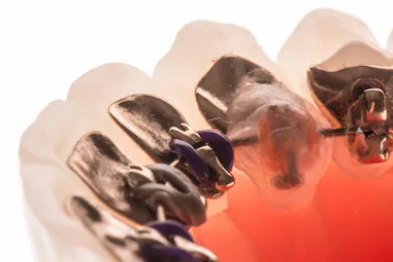What Are Lingual Braces?

Advances in dental technology through the years have made many dental procedures faster, less invasive, and more comfortable for the dental patient. One such advance in the world of dental appliances allows patients the opportunity to wear braces that are, for all intents and purposes, virtually invisible. Traditional braces are applied using standard brackets and wires applied to the outside (front side) of the teeth. Lingual braces, however, are applied to the inside (back side) of the teeth, making them almost impossible to detect. These hidden braces or “inside braces” were first introduced back in the 1970s and have undergone several design modifications and improvements throughout the ensuing decades that have made these braces behind the teeth more comfortable, practical, and effective in correcting teeth and bite problems. Compared to the early designs, current “inside braces” are highly advanced. While hidden braces are focused on improving the aesthetics, traditional braces are sometimes seen as a more affordable braces option.
How are lingual braces different from traditional braces?
In addition to being tucked away on the back side of the teeth and thereby almost totally hidden from view, lingual braces are applied to the patient’s teeth using a different technique than traditional braces. Whereas “regular” braces are applied to the teeth one bracket at a time using stock metal brackets, the brackets that hold hidden braces in place are custom fit to the inside of each tooth and are all cemented in place at the same time. A custom-fit tooth tray holds the brackets in place until the cement attaching them to each tooth has set, then the tray is removed. Once the brackets are cemented in place, wires and elastics are applied and adjusted by the orthodontist in essentially the same manner as with traditional braces. If you are
Are braces behind the teeth as effective as wearing regular braces?
Traditional braces generally tend to take one to two years to achieve the desired results. The length of time required for lingual braces to achieve similar results is virtually the same as traditional braces in most cases. These hidden braces can be more effective than “invisible” clear plastic forms that fit over the teeth to correct problems and misalignments, as patient compliance is not as much of a factor.
Can anyone wear hidden braces?
These non-traditional braces are best worn by teenagers and adults who have all their adult teeth. As long as each tooth is large enough to provide the orthodontist sufficient room to glue the individual brackets on the inside of the teeth, these braces can be worn by almost anyone. If there is a deep overbite, however, braces behind the teeth may not be a viable option due to the risk of the bite exerting too much pressure on the brackets and causing them to become detached from the teeth too easily.
If you are still asking yourself “what are lingual braces?” then give Taft Hill Orthodontics in Fort Collins a call at or fill out the form below to schedule a consultation.
